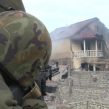
Government Forces in Dagestan Crack Down on Militant Stronghold in Gimry
Publication: Eurasia Daily Monitor Volume: 10 Issue: 70
By:

On April 11, government forces launched a large-scale counter-terrorism operation in the village of Gimry in Dagestan. The area was sealed off and all residents of the village were evacuated. As the security forces fought militants from the group headed by Ibragim Gajidadaev on the outskirts of the village, unidentified people from inside the village fired shots at them, wounding one serviceman. Therefore a decision was made to check the entire village (https://ria.ru/defense_safety/20130412/932338968.html).
Sources in the village told the Kavpolit.ru website that government forces were caught in the crossfire between the militants inside the village and the militants in the surrounding forests. The government side was forced to dispatch armored vehicles to the village and, according to some witnesses on the ground, the line of military vehicles extended one kilometer. Militants managed to hit one of the APCs with a grenade launcher. Officials identified three militants who were killed in the special operation in Gimry—35-year-old Shamil Abdullaev, 34-year-old Ilyas Kamilov and 28-year-old Abdula Zaguliev. The locals said that Gajidadaev, the notorious leader of the militants in the village, was alive and fighting government forces involved in the attack. Therefore, earlier government reports that Gajidadaev had been killed in a special operation in the town of Semender this past March were most likely premature (https://kavpolit.com/ibragim-gadzhidadaev-otstrelivaetsya-v-gimrax/).
The village of Gimry is located in the mountains of Dagestan and has a population of 4,000–5,000. It has historical significance from the 19th century Russian-Caucasian war: two famous imams that led the mountaineers’ struggle against the Russians, Gazimagomed and Shamil, were natives of Gimry. Reportedly, some houses in the village are connected to each other with a system of underground tunnels that makes it a natural stronghold to this day. Even though most residents of the village do not support the insurgents, as some residents assert, they are also unwilling to surrender one of their own to the government.
After two days of the special operation, reports spread that the militants had escaped the government forces once again. Special operations have become a yearly routine in Gimry since as far back as 2005. Sometimes the village would be blocked by security forces for most of the year. The village, in the past known for its trade in locally grown fruits, is gradually decaying because of the continual conflict. Both previous presidents of Dagestan, Magomedsalam Magomedov and Mukhu Aliev, rebuked the residents of Gimry en masse. “Enough to stand on ceremony with Gimrians,” Magomedov said menacingly, while his predecessor, Aliev, at one point even openly threatened to level the entire village (https://kavpolit.com/chuzhie-sredi-svoix-v-dagestane/).
In fact, according to some analysts, the authorities considered bombing the village during the latest round of violence. However, when the residents refused to leave their homes, the government backed down and the head of the administration of the village reached a deal through extensive mediation. According to the well-known Russian observer Orkhan Jemal, the government forced many peaceful Salafis into the underground movement after an extremely brutal special operation in 2007. That operation took place after Ibragim Gajidadaev killed a member of the Dagestani parliament, Gazimagomed Magomedov. Jemal alleged that the latter figure, besides being a Dagestani parliamentary deputy, also had his own armed group, engaged in racketeering, kidnappings, killings, and maintained a close relationship with the Russian security services.
Gajidadaev is not the only leader of the rebels in the village. According to Jemal, the rebels were later amnestied, but went underground again in the fall of 2010. The reason for rejoining the underground movement was, according to Jemal, the fact that the security services reverted to targeted killings of the Salafi leaders once they started to live openly after the amnesty. Thus, the Salafi leaders of the village decided that living underground was safer than residing in the village under the supposed government amnesty (https://kavpolit.com/gruppirovki-v-gimrax/).
The authorities are eager to portray the residents of Gimry as a stubborn, warlike breed of people consumed by their history of resistance to Russian rule and by Salafi extremism. Some analysts even allege that Gimrians are in the service of Dagestani clans to stir up the situation in the republic when needed. The “bandits” in Gimry, according to a journalist named Milrad Fatullaev, have nothing to do with the Islamic insurgency in the North Caucasus. Instead, the group, according to Fatullaev, is simply a criminal entity that engaged in political killings and racketeering on orders from powerful Dagestani clans (https://kavpolit.com/gimrinskaya-cep-razomknuta/).
Relatively few insurgency movements have absolutely no connection to regular crime. So even if the Gimry jamaat has criminal leanings, it does not automatically make the jamaat a mere collection of criminals. Orkhan Jemal’s insights tell a much more familiar story about the lack of trust between the village residents and the authorities. The new leader of Dagestan, Ramazan Abdulatipov, appears to be following in the footsteps of his predecessors, reverting to crude force in dealing with dissent. This means we are likely to see more violence in Dagestan and hopes that Abdulatipov can pacify the republic might quickly fade away.




